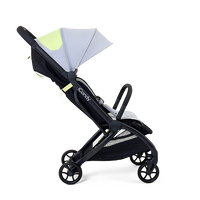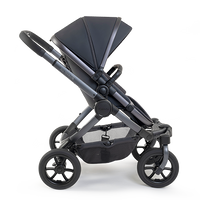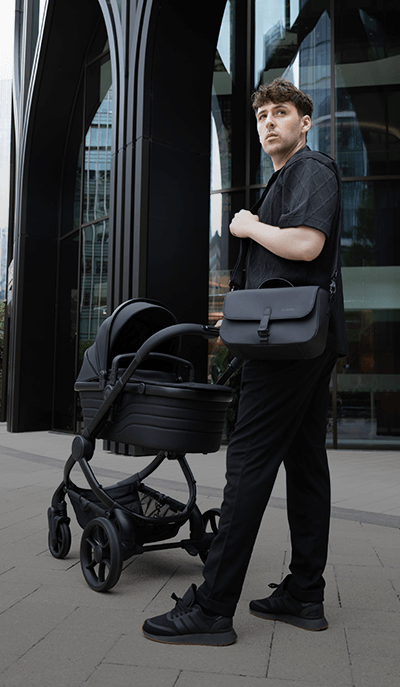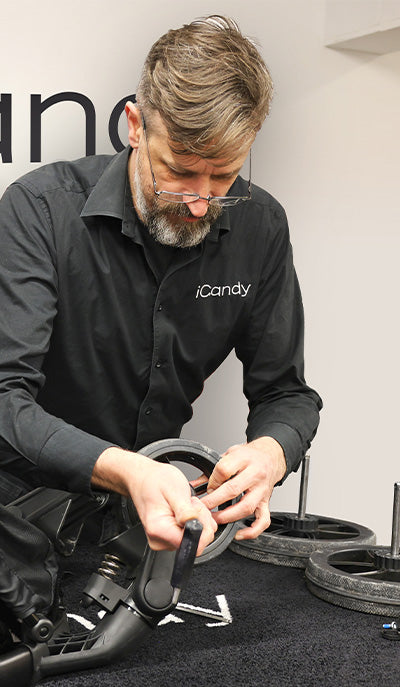
Pram Guide
The Ultimate Guide to Prams and Pushchairs
There are lots of factors to consider when it comes to buying a pushchair, and whilst this may seem like a daunting challenge at first, our expert backed guide provides trusted insights and practical advice. With industry expertise and real parenting experience, we break down pushchair jargon to help you make the best decision for you and your baby with confidence.
Within this guide you will find the answers to the most common questions asked by parents, for instance, “can my baby sleep in a pram overnight?” and “when can my baby move from a carrycot to a seat unit?”
Whether you use the guide in its entirety or simply dip in and out, it will help you to determine the perfect pushchair for your lifestyle, budget and baby.
For additional help in deciding which pushchair is perfect for you and your baby, please see the iCandy Pushchair Comparison.

Pushchair, Buggy, Stroller - What Is The Difference?
The best place to start when it comes to thinking about a pushchair is to breakdown the differences between the variety of models on the market. With so many categories, from prams and pushchairs to buggies, strollers and travel systems it can seem like a minefield of options.
Step one is to demystify the differences between them. This section of the Pushchair Guide takes things back to basics and considers the most important factors to note within each category.
What is the difference between pram and pushchairs?
The words ‘pram’ and ‘pushchair’ are often considered different terms for the same thing but a pram offers a lie-down position whilst a pushchair offers a seated position.

A pram allows baby to lie flat

A pushchair allows baby to sit up
What is a pushchair?
A pushchair is ideal for older babies at around 6 months of age. Whether you’re looking for a pushchair for a 1-year-old, a 2-year-old, or a 3-year-old, iCandy pushchairs are made to last. Many models can accommodate children up to 4 years old, but the key factor is weight. Designed to support up to 25kg (depending on the model), iCandy pushchairs provide a dependable solution for growing families. A good way to judge if a baby is ready for a pushchair is if they are able to sit up unaided. A pushchair generally offers the option for the baby to be forward-facing too and in this position, it's sometimes referred to as a ‘buggy’ which is another term that is used interchangeably.

| A pushchair is ideal for: | Age range | Benefits of a pushchair |
|---|---|---|
| Older babies and toddlers | +6 months |
|
| Parents who are out and about frequently with their child (e.g. walking, shopping or using public transportation) |

What is a pram?
A pram is for a newborn baby and offers a modern take on the traditional baby carriage whereby the baby lies flat. A flat position is advised for newborn babies to aid with lung and spinal development.
| A pram is ideal for: | Age range | Benefits of a Pram |
|---|---|---|
| Newborn babies | 0-6 months |
|
| Homes with a good amount of storage |
What is a stroller?
A stroller is an American term that is used to describe a lightweight version of a pushchair that is generally more compact and is designed for older babies or toddlers.
Strollers are often referred to as ‘umbrella strollers’ due to their slimline fold, however, they still maintain their length when folded so double check it will fit in your car boot. Strollers are a great option for holidays as they are lighter and more compact than most pushchairs. When purchasing a stroller specifically for a holiday it's important to consider the sun protection on offer and its reclining ability for nap times by the pool! Added accessories may be necessary when travelling with a stroller, such as bag clips or cup holders.

| A stroller is ideal for: | Age range | Benefits of a stroller |
|---|---|---|
| Babies (if the seat unit offers a lie-flat position) | 0-6 months (providing the seat unit offers a lie-flat position) +6 months |
|
| Toddlers | ||
| City dweller parents |

What is a double pushchair?
A double pushchair is designed to transport two children simultaneously, whether that be twins or a baby and a toddler. There are two different types of double pushchairs; a tandem where one child sits behind the other, or a wide side by side set up. The biggest difference between the two is the width. A tandem pushchair allows for easier manoeuvrability through doorways and on public transport. The evolution of the single to double pushchair means that a pushchair can grow with your family.
| A double buggy is ideal for: | Age range | Benefits of a double buggy |
|---|---|---|
| Twins | 0-6 months +6 months |
Ability to transport two children simultaneously |
| Toddler and baby |

What is a travel system?
A travel system consists of a pushchair frame, upon which other parts can easily be fitted. These parts include a carrycot, seat unit and a rear-facing car seat and when they are purchased as a package, they often provide good value for money.
However, most travel systems allow you the option to buy the elements separately, should you wish not to purchase all the products together as a package. Most pushchair brands include compatible car seat adaptors in the travel system package enabling the infant car seat to easily be clipped onto the wheels so that a sleeping baby can be moved seamlessly from car to pushchair.
Many car seat manufacturers recommend that a baby should spend no longer than 2 hours (30 minutes for newborns) in a car seat within a 24 hour time period. The benefit of a travel system bundle is that it includes all the parts needed to grow with your baby- once the baby has outgrown the car seat and carrycot, the seat unit can be used.
| A travel system is ideal for: | Age range | Benefits of a travel system |
|---|---|---|
| First time parents | 0-6 months +6 months |
|
| Parents with cars |

What is a three-wheel pushchair?
Three-wheel pushchairs are designed to travel on all types of ground. The two wheels at the back provide stability, whilst the front wheel provides manoeuvrability. These wheels are generally large and robust and ideally will be removable to allow for easy cleaning after a muddy trek!
Often a three-wheel pushchair is designed for off-road usage, but like an SUV, will be just as at home in urban environments too. A three-wheel pushchair is generally made with the active parent in mind and is designed to take children across all terrains in comfort thanks to the excellent suspension.
Puncture-proof tyres are important when it comes to an all-terrain pushchair so that parents can take their pushchair on any adventure with confidence.
A three-wheeled pushchair can be large, so it's important to check it will fit in your car boot or at home when folded.
| A three-wheel pushchair is ideal for: | Age range | Benefits of a three-wheel pushchair |
|---|---|---|
| Active parents | +6 months |
|
Introducing the iCandy EDITIONS Collection

The iCandy EDITIONS Collection is a curated selection of exclusive Peach 7 colourways, designed for parents who appreciate both timeless style and functionality.
Each EDITIONS features a bespoke chassis, carefully colour-matched to complement the luxurious fabric choices, ensuring a truly refined aesthetic. The collection introduces three sophisticated new colourways:
- Biscotti – A warm and neutral shade for an effortlessly elegant look.
- Coco – A rich and refined hue, perfect for a contemporary aesthetic.
- Pecan – A modern take on luxury, featuring ultra-luxe fabrics and a statement finish.
As part of the Peach 7 family, the EDITIONS Collection retains all the signature features that make it one of iCandy’s most sought-after pushchairs. From the spacious carrycot suitable for overnight sleeping to the one-handed fold and seamless single-to-double conversion, every detail has been designed with both style and practicality in mind.

Pram Features
Alongside a changing mat and bottles, a pram is likely to become one of your most used baby products! It's also the item that you’ll use for the longest so it’s important to consider the finer details that will make everyday life as easy and comfortable for parent and baby. In this section of the Pushchair Guide, we list important things to consider such as comfortable seat padding for the baby and an adjustable handlebar for parents.
What to look for when buying a pram: for the baby
Facing Directions
Most 'from birth' pushchairs offer two options when it comes to 'facing directions'. These directions are referred to as 'parent facing', otherwise known as rear-facing and 'world facing', otherwise known as forward-facing.
How long should a baby be in a carrycot?
Babies should be parent facing in a carrycot from birth until around 6 months or until they can sit up unaided, at which point they can progress into a seat unit. During their first 6 months it’s best for babies to be in parent facing mode so that there can be plenty of interaction between parent and baby during important developmental months.





































